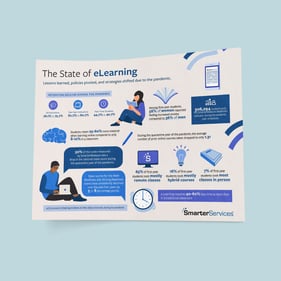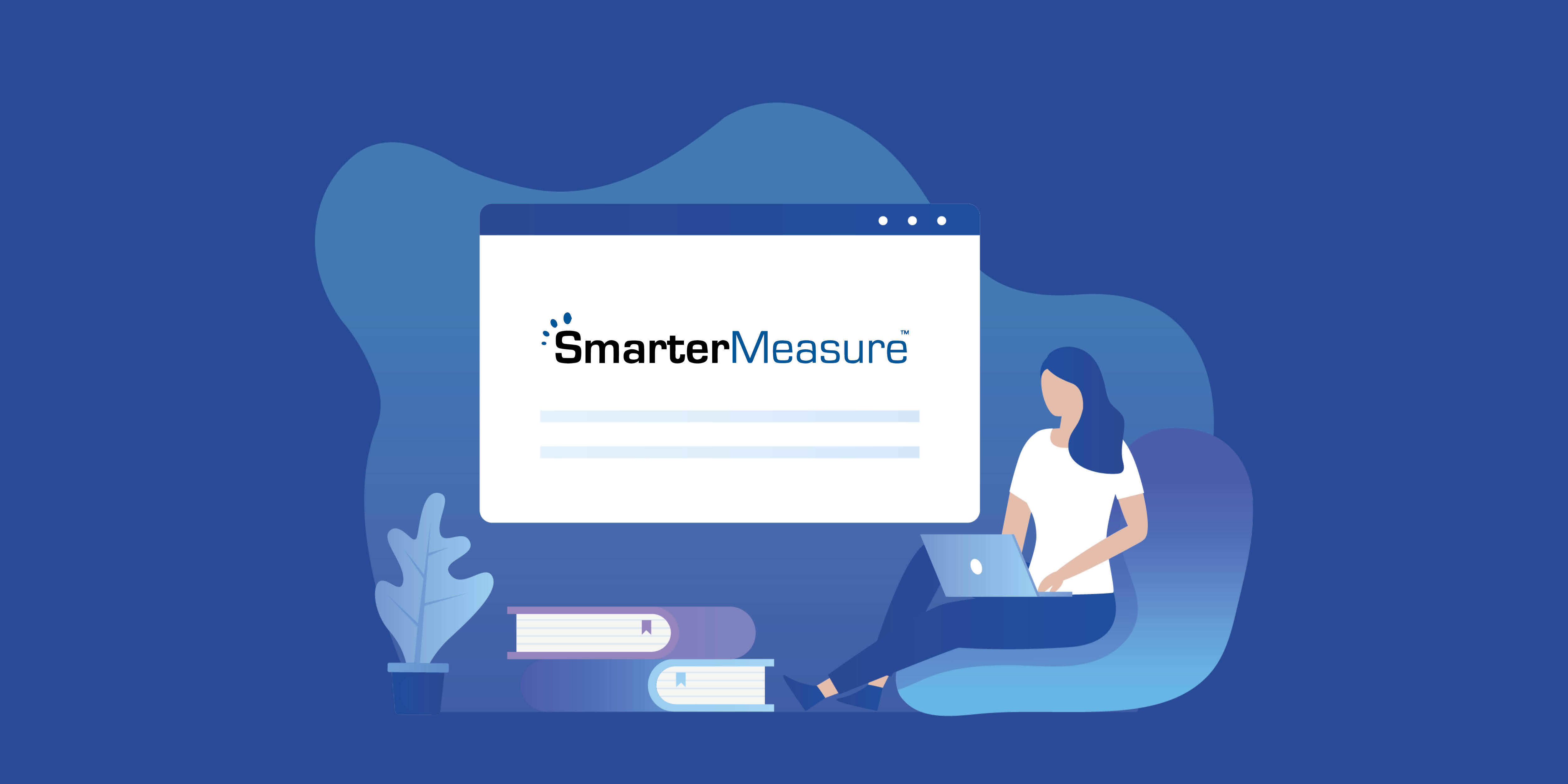
The rise of the eLearning at many educational institutions are unparalleled in school’s history. While there are certainly multiple negative impacts of the pandemic on American higher education institutions, many savvy schools are recognizing that some of the impromptu practices propelled by the pandemic can become permanent good practices. These observations are allowing schools to shift from surviving to thriving as they emerge from the pandemic.
In this blog, we’ll highlight some of the lessons learned, policies pivoted, and strategies shifted as a result of this global pandemic.
 This commentary will first reflect on the status of American higher education as a whole, followed by the current positioning of eLearning, and finally the status of two fundamental factors of eLearning — learner readiness and academic integrity.
This commentary will first reflect on the status of American higher education as a whole, followed by the current positioning of eLearning, and finally the status of two fundamental factors of eLearning — learner readiness and academic integrity.
The Status of Higher Ed
Mission Morphed
Due to the pandemic, schools evaluated their mission by moving away from a common emphasis on national institutional standings and focusing more on their local public role. Universities came to terms with the fact that they are not the sole curators of knowledge.
Peter Lake in Inside Higher Ed stated, “Many of the existential challenges now facing higher education are not new, and the pandemic has forced institutions to finally reckon with the fundamental issue of the true value of higher education from a student’s perspective… If colleges and universities want to thrive — or even survive — in a post-pandemic future, they must adopt a new mindset to address student expectations and redefine the inherent value of higher education.”
Technology Touted
Because of the pivot to technology-rich learning, schools’ relationships with technology had to be evaluated.
“Becoming digital should not mean doing away with universities; the student experience is about more than absorbing course content,” explained Mike Boxall of PA Consulting. “But universities need to find ways of not only being great with tech but also offering something more than an exchange of information.”
Consciousness Created
The crises of COVID-19 prompted an increased focus on diversity, equity, and inclusion. Students are now expecting meaningful institutional efforts to prevent and address matters including sexual violence, hazing, racist incidents, social consciousness, mental health, individual identity, digital divide, personal safety, and wellness.
Customer Courted
Viewing the student as a customer with expectations of their experience such as touch-of-a-button convenience for services provided by the institution is important. Otherwise, they may take their business elsewhere if their expectations are not met. Options of face-to-face, online, and hybrid course delivery systems for all courses are now expected. Students are also calling for lectures to be available online, even in face-to-face courses.
Retention Regressed
As reported by Inside Higher Ed, the National Student Clearinghouse reported that the nationwide pre-pandemic average level of retention for all American higher ed institutions was 76.1%. For 2020 during the start of the pandemic, that average declined to 75.7%. This decline was more severe among two-year institutions which saw a decline from 62.7% to 60.7%. Especially impacted were part-time students for which retention dropped 4% from 44.7% to 40.7%.
Doug Lederman concluded that “Students from underrepresented racial groups, those from low-income backgrounds, older students and students at community colleges have consistently borne the brunt of the impact of the pandemic and recession.”
Mental Wellness Measured
Alexander McCormick, Director of the National Survey of Student Engagement stated
A dramatic uptick in online learning during the pandemic wasn’t terribly surprising. However, the consequences of the pandemic for students’ mental wellness, especially among women, were a big worry. Female students were found to be more likely than men to experience mental health challenges during the pandemic. For example, among first-year students, 56% of women reported feeling increased anxiety that interfered with their daily functioning, compared to 36% of men. Female students also experienced heightened depression, hopelessness, mental and emotional exhaustion, and trouble sleeping at higher rates than their male peers.
Erica Riba, Director of Higher Education and Student Engagement at the Jed Foundation commented, “There was this level of mental exhaustion, having to navigate learning remotely against home life responsibilities,” she said. “Many students were sharing their homes with families and trying to navigate some of that stress. I think the communication chaos of the last few years — following protocols, stress around news — I think it was overwhelming for both the students in classrooms and the faculty and staff trying to navigate uncertainty and being fearful of infection and sort of this collective trauma.”
Partnership Prized
Schools have repositioned to be more collaborative through partnerships with the industry. Arizona State University, for example, has launched a research and innovation facility with Starbucks to design more sustainable ways to run its stores and refine employees’ decision-making skills.
Agility Acknowledged
Universities have recognized that they can be nimble and adapt when necessary, moving away from the common paradigm that change moves at the speed of molasses in higher education.
The Status of eLearning
Practices Prioritized
As reported in Campus Technology, the CHLOE annual survey asked higher education leaders if the pivot to remote learning during the COVID-19 pandemic changed their institution’s priorities, the majority of respondents replied “Yes.”
Practices that have now been prioritized include:
- Expanding online course and program offerings
- Recognizing and supporting online learning programs and needs
- Increasing flexibility to meet student needs with multiple teaching modes
- Applying quality standards to online courses
- Ensuring accessibility of online course materials
- Improving technical infrastructure
- Expanding online student services such as counseling
The CHLOE report concluded, “These strategic initiatives appear to augur a shift in institutional priorities toward the further integration of online learning into the mainstream of primarily campus-based institutions.”
Options Offered
Almost all institutions made a pivot at some level that involved eLearning during the pandemic. Most of these institutions plan to continue making these eLearning options available as the pandemic diminishes.
A finding of the 2021 National Survey of Student Engagement was that the majority of first-year students (65%) took mostly remote classes, 16% took mostly hybrid courses and only 7% took most of their classes in person. Similarly, 66% of seniors took most of their courses remotely, 13% were mostly in hybrid courses and only 11% were mostly taking classes on campus.
Effectiveness Extolled
There is compelling research shared by Shift eLearning that shows that on average, students retain 82% more material when learning online compared to only 8-10% in a classroom. This is mostly due to the students being able to learn faster online; e-learning requires 40-60% less time to learn than in a traditional classroom setting because students can learn at their own pace, going back and re-reading, skipping, or accelerating through concepts as they choose.
Plus, in well-designed online courses, students can choose to consume content in a manner that best fits their learning style (i.e. reading text, watching a video, engaging in a discussion board).
The Status of Learner Readiness and Integrity
Learner Readiness
Readiness Reframed
The readiness-related question changed from “Is eLearning a good fit for me?” to “How can a learner like me be successful learning online?”
Before the pandemic, the construct of online learner readiness was often focused on the goal of assisting a learner in determining the degree to which “online learning is a good fit for me.” The pandemic changed the paradigm so that now online learner readiness has more of a focus on “How can a learner like me be successful learning online?”.
Experienced Exploded
As shown in the table below, during the quarantine year more students with no prior online learning experience studied online than ever before. One positive note is that after the quarantine year there are now a higher number of students who have experienced learning online.
Means Measured
During the quarantine year (2020) of the pandemic, a record number of over a half-million students took the SmarterMeasure Learning Readiness Indicator. A comparison of the mean scores during that time compared to before the pandemic and now as we are emerging from the pandemic revealed the impact that the pandemic had on learner readiness.
| Life Factors | Individual Attributes | Reading Recall | Technical Knowledge | Technical Competency | LMS Competency | Math Readiness | Writing Readiness | Typing AWP M | N | |
| AY 17/18 | 79.03 | 78.62 | 71.58 | 72.01 | 90.54 | NA | 80.30 | 61.62 | 27.25 | 383,038 |
| AY 18/19 | 79.14 | 78.50 | 72.45 | 71.02 | 90.59 | 88.53 | 79.80 | 78.42 | 26.89 | 403,746 |
| AY 19/20 | 78.61 | 77.12 | 70.72 | 68.55 | 88.87 | 89.89 | 75.13 | 74.27 | 25.95 | 506,294 |
| AY 20/21 | 77.28 | 76.02 | 72.58 | 73.35 | 90.03 | 77.21 | 75.10 | 70.71 | 26.64 | 467,857 |

- Impact of the Pandemic on Skills:
- During the COVID-19 pandemic, many institutions closed their doors and moved much instruction online. This prompted many students for whom online learning was not their first choice to be constrained to learn by an online learning modality.
- This reduction in levels of learner readiness is demonstrated by the lowest mean on half of the scales we measure being experienced during the quarantine year of AY 19/20.
- The following scales revealed the lowest means during that year: Reading Recall, Technical Knowledge, Technical Competency, Keyboarding.
- Declining Non-Cognitive Attributes:
- Mean scores on the Life Factors and Individual Attributes scales have consistently declined over the past four years by about two percentage points. This is a substantial observation since these scales measure learner attributes, not skills.
- As such, these measurements are not delivery system dependent, meaning that they are equally important for students studying online, hybrid, or face-to-face.
- It is paramount that institutions measure this data for all students and provide appropriate strategies for intervention and support since students are struggling more in these areas than in the past.
- Declining Cognitive Performance:
- Generally speaking, mean scores for the Math Readiness and Writing Readiness scales have consistently declined over the past four years by 5 to 8 percentage points.
Learner Integrity
Assessment Assessed
During the quarantine phase in 2020, many institutions reported a dramatic increase in academic integrity violations.
As reported by NPR, “At Virginia Commonwealth University, reports of academic misconduct soared during the 2020-21 school year, to 1,077 — more than three times the previous year's number. At the University of Georgia, cases more than doubled; from 228 in the fall of 2019 to more than 600 last fall. And, at The Ohio State University, reported incidents of cheating were up more than 50% over the year before.”
As a result of this, several different assessment strategies were tried ranging from making all tests open resource but with synthesis level questions to keeping objective question types but utilizing automated virtual proctoring. Faculty reported time-consuming issues with both of these extremes. Rewriting exam content and grading open-ended questions certainly took more time as did evaluating frequent false positives such as a child walking in the room reported by automated virtual proctoring.
Testing Centers Tested
The quarantine phase of the pandemic in 2020 was certainly devasting to the mission and operation of collegiate testing centers. But over time the employees of some testing centers began to be recognized as the assessment experts as assisted faculty as they redesigned their exams. As testing centers reopened with limited availability, priority was often given to persons who needed the assistive devices provided by the testing centers.
Finally, some testing centers are adopting Hybrid Virtual Proctoring which allows the trained proctors who are employees of collegiate testing centers to serve as the virtual proctors even if they are working remotely. This may reduce testing anxiety for some learners as the proctor is a person from the institution, not someone in a different country. This also puts the testing center in control of the quality of the proctoring experience so that they can provide a more user-friendly, assistive, and comforting testing experience for the students of their institution.
Hybrid Happened
The word that is emerging as a lasting impact from the pandemic is “Hybrid.” We are working in hybrid environments, learning in hybrid environments, and now there is a hybrid testing environment as well.
Hybrid Virtual Proctoring allows for someone from the institution such as a trained testing center employee, the faculty member, someone from the eLearning staff, or graduate assistants to serve as the virtual proctor. This helps control costs since the services of a live proctor outside of the institution are not having to be paid for. It can also provide a more comforting, assuring proctoring experience for the student.
Continuing the Shift from Surviving to Thriving
For more information about how your institution can continue to thrive during this time, please check out the following free resources below, or click here to contact us for more information.
Blogs:
- Pandemic Proctoring: Practical Approaches for Hybrid Proctoring
- What a Positive Proctoring Experience Should Look Like
- How to Proctor without Panicking, Pestering, or Provoking Your Students
- How to Support Learner Readiness When it Matters the Most
- How to Support Your Students through the use of Non-Cognitive Data
Free Downloads:





.jpg)


